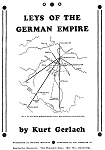
By Kurt Gerlach
Translation and Preface by Michael Behrend
“Leys” in Britain are the straight alinements of prehistoric sites discovered in 1921 by Alfred Watkins, who believed they marked the course of ancient tracks. In the 30’s and 40’s, while members of the Straight Track Club were following up the work of Watkins, similar work was going on in Germany in connection with the orientation theory. The basic idea, stemming apparently from the work of Norman Lockyer in the early years of this century, was that prehistoric sites and ancient churches marked out lines across the landscape pointing to the sun, moon, and stars; though some researchers, such as Gerlach and Heinsch, had other explanations for the lines. The grand old man of this school of thought was a clergyman, Wilhelm Teudt. Watkins was virtually unknown in Germany, although his follower Major F.C. Tyler, author of The Geometrical Arrangement of Ancient Sites, was in contact with Heinsch and refers to an English translation of Heinsch’s work by R.P. Jones.
The essays reprinted here appeared between 1940 and 1943 in Germanien, a monthly magazine that in the elevenfifteen (1929–1943) years of its existence published a wealth of material on folklore and alternative archaeology. Contributors were expected to conform politically rather than academically, so that many articles were published that would never have made the pages of Antiquity, for instance. The alinements which Gerlach describes are not prehistoric, but are marked out by church foundations of the tenth to twelfth centuries. Their purpose is similar to that of Watkins’s leys: to provide lines of communication and aide travellers across the landscape. The first of these articles, published in 1940, concerns itself with the Dresden–Leipzig–Prague region, supported by details of local history such as an English researcher might dig out of the Victoria county histories. In the later articles we see how Gerlach’s vision broadens to encompass a vast network of alinements across northern and central Europe: a theory without precedent, as far as we know, except in the lost work of the 19th-century English researcher W.H. Black, of whom Gerlach had probably never heard. Black’s “grand geometric lines”, as he called them, were the work of the Romans; Gerlach’s were drawn out by Benedictine monks as part of the German empire’s efforts to bring civilization to the pagans of the north and east.
The pages of Germanien give us no information about Gerlach himself save that he lived at Hellerau, a small town near Dresden. In 1929, however, the playwright and novelist Kurt Gerlach published several children’s plays at Hellerau; his daughter Tine Schulze-Gerlach, also a novelist, was born there in 1920. In 1943 this Kurt Gerlach published a novel The Road to Prague, and the following year one about St Vitus and the “black brothers” or Benedictines. It seems almost certain, then, that he is the author of the pieces reprinted here. He was born on 3rd March 1889 in Dresden, and received a doctorate from Leipzig University in 1912. He was an authority on the drama (note his quotations from Shakespeare) and worked as a teacher and as a forester. Perhaps it was while working in the forests of his native district that he became fascinated by long-distance communication through the mountains. Gerlach died as recently as 13th March 1976, just when members of the Institute of Geomantic Research were rediscovering his work.
An abridged version of Gerlach’s work, translated in part by Prudence Jones, was published by the IGR in 1976. The present translation is new, but remains indebted to Jones in many places.
Update by Michael Behrend, April 2012
Besides the work of Black mentioned above, J.H. Spencer’s article “Ancient Trackways in England” (1889) partly anticipates Gerlach’s theory of land surveying for long-distance communications, although it is not worked out in the same detail.
In the IGR version of “Early German Land Surveys”, I tried to put the material into a more logical order by moving a few paragraphs from the second instalment into the first. Now that the German original is being republished along with the translation, it seems better to restore the original order. But I have kept two other changes made in the IGR version: inline references are replaced by endnotes, and the text is broken up by added subheadings (in italics).
Many places in the regions considered have two names, one German and one in another (usually Slavonic) language. Gerlach nearly always uses the German name. As in the IGR version, I use the form that belongs to the official language of the country, e.g. Děčín not Tetschen. For this Web version I have however changed the Czech “Praha” to the familiar English form “Prague”.
The IGR version was duplicated from typed stencils and it was not practicable to include all the maps and illustrations. In this Web version, have all been included, as has the introductory note added to “Early German Land Surveys” by the editor of Germanien.